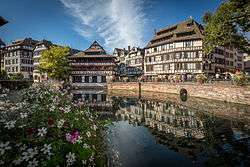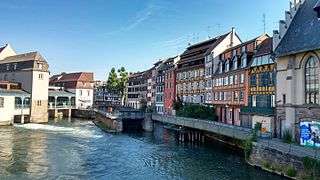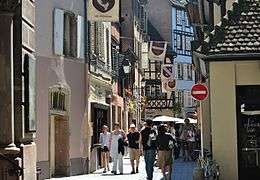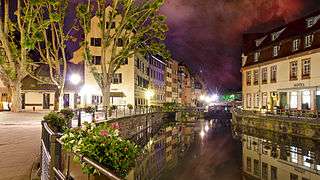Petite France, Strasbourg
La Petite France (also known as the Quartier des Tanneurs; German: Gerberviertel; "Tanner's Quarter") is a historic quarter of the city of Strasbourg in eastern France. It is located at the western end of the Grande Île, which contains the historical centre of the city. At Petite France, the River Ill splits up into a number of channels that cascade through an area that was, in the Middle Ages, home to the city's tanners, millers and fishermen, and is now one of Strasbourg's main tourist attractions. Petite France forms part of the UNESCO World Heritage Site of Grande Île, designated in 1988.[1][2]
Petite France | |
|---|---|
Historic quarter | |
 The Maison des Tanneurs and Place Benjamin-Zix in the heart of the quarter | |
 Petite France Petite France in relation to the city of Strasborg | |
| Coordinates: 48°34′51″N 7°44′26″E | |
| Country | France |
| Region | Alsace |
| Department | Bas-Rhin |
| Commune | Strasbourg |
Just upstream of Petite France, the River Ill flows through the Barrage Vauban, a defensive structure built at the end of the 17th century. Downstream of this, the river splits into the Canal du Faux-Rempart, which flows to the north of the Grande Île, and four channels which flow through the Petite France quarter before reuniting in the main channel of the river, flowing to the south of the Grande Île. These four channels are spanned by the Ponts Couverts, an earlier defensive structure of three bridges and four towers that, despite its name, has not been covered since the 18th century.[3]
Downstream of the Ponts Couverts, the four channels flow through an area of largely half-timbered buildings which, together with the narrow lanes and footbridges that connect them, mostly date from the 16th and 17th centuries. The sloping roofs of many of the buildings include open lofts where hides were once dried. Three of the four channels flowing through the quarter run over weirs that once drove mills and other industries, whilst the northernmost channel is navigable. This passes through a lock and the Pont du Faisan swing bridge in the centre of the quarter, and is largely used by passenger trip boats.[1][3][4]
On the north bank of the Ill at the heart of the quarter is the Maison des Tanneurs, home of the Tanner's Guild, and Place Benjamin-Zix. From this square lead several streets, including the Rue du Bain-aux-Plantes and the Rue des Dentelles, also lined by half-timbered houses. To the east these lead to the Saint-Thomas church, the city’s main Lutheran church, and to the west back to the Pont Couverts and to the Saint-Pierre-le-Vieux church, actually two churches (one Protestant and one Catholic) in the same building.[3]
The name Petite-France ("Little France") was not given for patriotic or architectural reasons. It comes from the "hospice of the syphilitic" (Hospice des Vérolés, in French), which was built in the late fifteenth century on this island, to cure persons with syphilis, then called Franzosenkrankheit ("French disease") in German.[5]
Gallery
 The quarter's weirs, lock and half-timbered buildings
The quarter's weirs, lock and half-timbered buildings.jpg) A trip boat on the River Ill
A trip boat on the River Ill The Rue des Dentelles, one of the quarter's narrow streets
The Rue des Dentelles, one of the quarter's narrow streets The Pont du Faisan, one of the quarter's bridges
The Pont du Faisan, one of the quarter's bridges Petite France by night
Petite France by night
References
| Wikimedia Commons has media related to Petite France. |
- "The Petite France quarter". Office de tourisme de Strasbourg et sa région. Archived from the original on 26 September 2015. Retrieved 25 September 2015.
- "Strasbourg – Grande île". UNESCO World Heritage Centre. Retrieved 26 September 2015.
- "Strasbourg Petite France District". French Moments. Archived from the original on 26 September 2015. Retrieved 26 September 2015.
- McKnight, Hugh (2013). Cruising French Waterways, Kindle Edition. Adlard Coles. p. 115. Retrieved 24 September 2015.
- Strasbourg insolite et secret, L. Maechel & T. Rieger, p. 74.